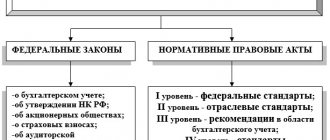Write-off of receivables can be of two types: taken into account for tax purposes and not taken into account. Since when calculating tax when applying the simplified tax system, debt is not recognized as an expense (clause 1 of Article 346.16 of the Tax Code of the Russian Federation, Letter of the Ministry of Finance of the Russian Federation dated November 13, 2007 No. 03-11-04/2/274), this article will be of interest primarily for organizations on OSNO. Let's consider what requirements must be met for write-off and how to formalize this procedure in 1C: Accounting 8, ed. 3.0.
- Requirements for writing off accounts receivable
- Where does the write-off procedure begin?
- How to register a write-off in “1C: Accounting 8”, ed. 3.0
- What to do with unconfirmed receivables
Why do you need to confirm the debt?
It is obvious that the debtor agrees with his debt and - most importantly - pays it off.
This is required by the norms of civil legislation regulating business activities. In particular, by virtue of paragraph 3 of Art. 1 of the Civil Code of the Russian Federation, when establishing, exercising and protecting civil rights and when performing civil duties, participants in civil legal relations must act in good faith. According to paragraph 4 of Art. 1 of the Civil Code of the Russian Federation, no one has the right to take advantage of their illegal or dishonest behavior. In the process of transactions (execution of contract terms), the parties have rights, requirements and obligations. The latter must be executed properly in accordance with their terms and provisions of the law (Article 309 of the Civil Code of the Russian Federation). The debtor bears the costs of fulfilling the obligation based on its terms. In particular, upon receiving the goods, the buyer must pay for it. Likewise, the seller must ship the goods upon receipt of advance payment. Documents confirming the occurrence of obligations are shipping (waybills, waybills) and banking (payment orders, bank account statements) documents.
With services it is more difficult. It is more difficult to confirm the fact of their provision, and, accordingly, the emergence of an obligation to the customer to the contractor, especially if there is no tangible result. In civil legislation (neither in Chapter 37 “Contracting”, nor in Chapter 39 “Paid provision of services”) there are no clear instructions on how a contractor (performer) can record the volume and cost of work performed (services provided) and confirm them with documents. It all depends on the specific situation.
Registration of write-offs in “1C: Accounting 8”, ed. 3.0
Next, an “Order for conducting an inventory” and an “Inventory report for settlements” are drawn up. In "1C: Accounting 8", ed. 3.0, it is reflected like this. In the upper left corner you need to click the yellow arrow icon and open the main menu, select “All functions”
.
In the window that opens, select the “Documents”
and select the required form (
“Settlements Inventory Report”
).
In the act in the field “Accounts receivable”
the counterparty and the amount of the debt are selected, in the
“Settlement accounts”
we mark the necessary ones, in the
“Inventory taking”
the order data is entered: the number and date of the base document and the reason (for example, liquidation of the counterparty), in the
“Inventory commission”
the selected chairman and members of the commission.
Next, the order (Form INV-22) and the act (Form INV-17) are printed.
Based on the act, the “Inventory certificate of settlements with buyers, suppliers and other debtors and creditors”
. The certificate indicates documents confirming the debt (invoices, certificates of work performed, services rendered).
After these measures are taken, an order is issued to write off the receivables (due to the impossibility of collection). The order is issued in free form. It contains information about the organization/entrepreneur-debtor, documents confirming the existence of the debt, its size and period of formation (agreement, primary documentation, payment order and bank statement certified by the bank), the amount of write-off. Please note that the payment order and bank statement, certified electronically, must be certified for the court by a living seal and signature at the bank.
Next in the program, debt adjustment is processed. It is located in the "Sales"
in the column
“Settlements with counterparties”
.
In the adjustment, select the type of operation “Debt write-off”
and in the
“Write off”
select the appropriate item.
In the “Buyer’s debt...”
, select the counterparty and the amount of debt, and in the
“Write-off account”
– account 91.02 and in expenses –
“Write-off of receivables (payables)”
.
If there is a reserve for doubtful debts, then the amount is written off at its expense. If the debt amount exceeds the reserve amount, the balance goes to expenses on account 91.02.
If it is possible to collect the debt in the future, then it is taken into account for 5 years in off-balance sheet account 007 in the context of counterparties.
If it is impossible to collect the debt - the individual entrepreneur has died, the organization has been liquidated and other options, the write-off order must indicate that the debt will not be taken into account in account 007 and for what reason.
As a result, after all the activities, you will have a package of documents in your hands:
- order to conduct an inventory;
- powers of attorney for third-party individuals - members of the commission (if any);
- act of inventory of payments;
- certificate of inventory of settlements with buyers, suppliers and other debtors and creditors;
- order to write off debt;
- an extract from the Unified State Register of Legal Entities or Unified State Register of Individual Entrepreneurs on the liquidation of the organization, exclusion of individual entrepreneurs from the register (if any);
- court decisions.
All these documents, as well as those confirming the written off debt, must be kept for 5 years.
When making a debt adjustment, you need to take into account that when making an advance to a supplier, in the “Write off”
you need to indicate
“Advances to suppliers”
.
When might debt documents not be enough?
Communication services are quite specific and evidence of their provision must be data from special certified equipment.
In the absence of such proper confirmation, the service provider may be refused to collect the debt. Example - Resolution of the Ninth Arbitration Court of Appeal dated January 17, 2017 No. 09AP-60602/2016. As evidence of the stated demand for debt repayment, the contractor presented invoices, details of the invoice for communication services, invoices, certificates of work performed (services rendered) indicating their cost for the reporting period.
The basis for making payments for communication services is the readings of communication equipment, which takes into account the volume of communication services provided by the operator (Article 54 of the Communications Law). Equipment used by the telecom operator to record the volume of services provided and automated payment systems are subject to mandatory certification (Resolution of the Government of the Russian Federation dated June 25, 2009 No. 532).
During the trial, the plaintiff did not provide information about which equipment was used to record the services provided, and the connection certificates, the obligation to sign which are specified in the contract, were not presented. In particular, telephone services were provided as part of separate orders. Each of them comes into force after signing by the customer - the user of telephone services.
The operator did not submit these documents; instead, the arbitrators were offered evidence of sending primary documents through a specialized Internet resource and details of the communication services provided, which, according to the terms of the contract and the requirements of the legislation in the field of communications, was not evidence of the provision of communication services to their customer.
For comparison, in the Decree of AS PO dated December 19, 2016 No. F06-15147/2016, the operator had to submit the following documents confirming the accuracy of the information contained in the details of the provision of services: permission to operate a communication facility with an application, a certificate of conformity of equipment with an application, as well as a response Department of the Federal Service for Supervision of Communications, Information Technology and Mass Communications on the extension of permits to operate the equipment specified in the appendix to the letter. These documents confirmed the fact that the plaintiff used certified equipment to record the volume of services provided, ensuring the correct recording of connections and their duration.
From doubtful debt to hopeless debt
Doubtful debt is debt associated with the sale of goods, works, services, if it is not repaid within the time limits established by the agreement and is not secured by a pledge, surety, or guarantee.
The doubtful debt will either be repaid by the debtor in the future (in whole or in part), or will turn into a bad debt.
It is impossible to collect an uncollectible debt. That is, part of the money or assets is completely lost. There is a loss. Such a loss can be attributed to non-operating expenses or written off against the created reserve for doubtful debts.
The reserve is created only for doubtful debts arising in connection with the sale. No reserve is created for overdue advances to suppliers.
Firms that create a reserve for doubtful debts write off debts recognized as bad debts from this reserve. If the reserve is not enough, the difference is charged to non-operating expenses.
Those who do not create a reserve also reduce their tax liabilities, but not before the moment when the debt is recognized as bad.
But not every debt can be considered bad enough to be written off.
The debt is recognized as a bad debt and is taken into account as part of non-operating expenses of the reporting period on the date of expiration of the limitation period, as well as upon the occurrence of the circumstances listed in clause 2 of Art. 266 Tax Code of the Russian Federation.
Do not forget about the statement of reconciliation of calculations
The arbitrators recalled this important document in the Resolution of the Ninth Arbitration Court of Appeal dated January 11, 2017 No. 09AP-61172/2016-GK.
In this case, the operator provided not entirely traditional services: reserving places in line cable structures (LCS) for placing the user’s communication cables, couplings for optical communication cables, and operating the LCS for the specified purposes. In accordance with the terms of the concluded agreement, the contractor presents to the user after the end of each month of provision of services an invoice and an act of provision of services (performance of work) in two copies. The named documents were submitted in full to the case file, but the defendant considered them illegitimate, since he considered the agreement itself to be invalid. The customer transferred the cables to third parties without properly notifying the contractor in whose LCS the cables were located.
The operator, as the plaintiff, presented a statement of reconciliation of accounts, signed by both parties to the case, which confirms the defendant’s recognition of the existence of a debt for the disputed period. The defendant’s argument that the lines were on the balance sheet not only of him, but also of third parties, does not refute the plaintiff’s arguments that services were provided to the defendant. The defendant did not submit a reasoned refusal to sign certificates of services rendered (work performed) in the case file.
For your information
The act of reconciliation of settlements with counterparties does not apply to primary documents. Calculations are confirmed by acts of services rendered (work performed) and payment documents. Therefore, the accountant has the right to draw up a reconciliation report in any form and with details convenient for him. Their set is minimal, as evidenced by the documents provided in many software and application products - reconciliation acts. They include information about the counterparty with whom the reconciliation is being carried out, as well as dates and numbers of primary documents confirming business transactions, including the amounts for which they were made when the parties executed the transaction.
It turns out that a reconciliation act can help not only confirm settlements with the counterparty, but also justify and correctly calculate penalties in the event of a partner’s failure to fulfill its obligations. Let us remind you: according to paragraph 1 of Art. 330 of the Civil Code of the Russian Federation, a penalty (fine, penalty) is a sum of money determined by law or contract, which the debtor is obliged to pay to the creditor in the event of non-fulfillment or improper fulfillment of an obligation, in particular in case of delay in fulfillment.
The date of receipt of income in the form of fines, penalties and (or) other sanctions for violation of contractual or debt obligations, as well as in the form of amounts of compensation for losses (damage) is the date of their recognition by the debtor or the date of entry into legal force of the court decision. If the creditor takes into account the specified amounts on the date of their recognition by the borrower, a document indicating the recognition by the debtor of the obligation to pay the creditor in full or in a lesser amount of fines, penalties, and other sanctions for violation of contractual obligations may be a bilateral act signed by the parties (agreement on termination of the contract , reconciliation act, etc.) (letter of the Federal Tax Service of the Russian Federation dated January 10, 2014 No. GD-4-3/ [email protected] , Ministry of Finance of the Russian Federation dated October 30, 2014 No. 03‑03‑06/1/54946).
In the absence of a signed reconciliation report or full or partial actual payment to the creditor of the amounts of sanctions indicating the debtor’s recognition of the obligation to pay fines, penalties, and other sanctions, there are no grounds for recognizing the corresponding amounts as part of the creditor’s income (Letter of the Federal Tax Service of the Russian Federation dated June 23, 2016 No. SD -4-3/ [email protected] ). Consequently, the debtor in such a situation can make claims regarding the correctness of the calculation of penalties.
Write-off procedure
The write-off procedure begins with an inventory of payments. To carry it out, the chairman of the inventory commission and its members are elected. Members of the commission can be both employees of the organization and third-party individuals, but in this case they need to issue a power of attorney to carry out activities to take inventory of receivables. The presence of debts, their size and documentary evidence or lack thereof are checked.
When considering debt, commission members should pay attention to the following points that do not allow the debt to be considered bad:
- the debtor confirmed his obligations by signing a reconciliation report;
- a written agreement has been concluded to acknowledge the existence of a debt;
- payment was received to repay a debt, interest or penalty;
- a letter has been received indicating that the organization/individual entrepreneur acknowledges its debt;
- a letter has been received requesting a deferred payment;
- a lawsuit was filed to collect the debt.
If the debt falls under clauses 1-5, then the statute of limitations (three years) should be counted anew, but not exceed 10 years from the date the debt was formed in accordance with clause 1 of Art. 181 Civil Code of the Russian Federation.
How to prove the existence of a debt for excess traffic?
The need for this arises when using fixed payments in calculations, as, for example, happened in the case considered in the Resolution of the AS SZO dated January 16, 2017 No. F07-12700/2016.
The subject of the agreement concluded between the operators was interconnection. The Contractor agreed to provide the customer with services for connecting networks, as well as for transmitting traffic. The parties agreed that invoices for the service of connecting the parties’ networks and other one-time payments are issued by the contractor before the start of the provision of services. Invoices for the monthly traffic fee (and all other periodic payments) are issued by the contractor prior to the start of the period in which the services will be provided.
Payment for excess traffic volume or additionally paid traffic is made monthly after the provision of services and the signing of the acceptance certificate for the services provided. The Contractor issues a separate invoice to the customer for excess traffic or includes the price of excess traffic as a separate line in the next invoice.
In support of the demand for debt collection, the contractor presented the following evidence: an extract from the automated system about the excess traffic volume, copies of invoices and acceptance certificates for services provided, lists of postal items, electronic correspondence between the parties. At first, the judges did not accept this correspondence, since the parties did not agree on the possibility of sending documents by e-mail.
Meanwhile, the electronic correspondence is presented by the operator not as evidence of sending documents to the subscriber (acts and invoices were sent by mail), but as confirmation of receipt of the said documents. Moreover, the subscriber did not dispute the existence of email correspondence between the parties, as well as the authority of the person conducting this correspondence. The authority of the chief accountant, who signed and thereby certified the extract from the automated system, was also questioned. We believe that this does not deprive the document of legitimacy.
The case has been sent for new consideration, and there is every reason to believe that the documents presented by the operator will be sufficient to confirm the debt for services provided that exceed the established traffic “quota”.
Are contractual relationships required?
In the process of commercial activity, subjects of legal relations formalize them among themselves in order to be able to protect their rights and interests.
This is required not only by the requirements of civil law, but also by business customs. In addition, there is a direct rule obliging operators to provide communication services to users on the territory of the Russian Federation on the basis of an agreement on the provision of communication services. The user with whom the contractual relationship is concluded is a subscriber who is obliged to pay for the services provided to him. However, in practice, not everyone who uses communication services is a subscriber. Sometimes services are consumed by persons with whom contractual relations have not been formalized in the prescribed manner. Does this give them the right not to pay bills for consumed communication services?
A systemic interpretation of the provisions of the Communications Law leads to the conclusion that users of communication services are required to pay (regardless of whether or not telecom operators have formalized relations with them). This is confirmed by court decisions. One of the situations encountered is the lack of contractual relations among government customers. Or rather, there were initially contractual relations, but then the contract expired, nevertheless, the operator continues to provide communication services even without a contract.
He is obligated to do this by the aforementioned law, according to which telecom operators do not have the right to unilaterally suspend and (or) terminate the provision of communication services for the needs of defense, state security and law enforcement. Therefore, operators cannot stop providing services due to the lack of a government contract, which does not relieve the customer who has consumed the services from the obligation to pay for them. Resolution of the AS SZO dated January 13, 2017 No. F07-12336/2016 is further proof of this.
The provision of services to a military institution as a government customer is confirmed by data obtained using the plaintiff’s equipment used to record the volume of communication services provided, invoices, and invoices for payment. This is enough to satisfy the claim of the service provider even without a valid contract. Moreover, even in the described case, relations between the parties took place (business transactions were carried out), they were simply not formalized in the prescribed manner.
When do documents fail to prove a debt?
It turns out that such situations occur in the practice of operators, one of them is unauthorized access to the network by third parties.
The obligation to counteract this lies with the operators, and therefore if they treat it negligently, then their attempts to collect the debt from the subscriber for communication services that he did not actually consume (due to access to them by third parties) will be unsuccessful. Let us turn to the Resolution of the AS UO dated December 16, 2016 No. F09-10392/16. The subscriber was billed for international communication services that he did not order or consume. Based on the fact of an unauthorized connection, the subscriber contacted the investigative authorities, but the initiation of a criminal case was refused due to the fact that access to the subscriber line was free for a sufficiently long distance.
Thus, proper measures were not taken by the telecom operator to protect telephone lines. Moreover, actions to prevent unauthorized access were carried out by the subscriber himself, who demanded that the provision of long-distance communication services be stopped in advance. However, the operator continued to provide these services without ensuring adequate protection of the communication line. The inspection reports submitted by the operator, refuting what was said and drawn up unilaterally, were not taken into account by the arbitrators. As a result, the telecom operator was unable to prove the subscriber’s debt for the disputed services.
For comparison: in a similar situation, the operator was able to prove the subscriber’s debt for significantly exceeded consumed services. But the consumer of mobile communications services was largely to blame for this. As follows from the Resolution of the Ninth Arbitration Court of Appeal dated December 8, 2016 No. 09AP-55053/2016-GK, the operator provided the enterprise with corporate communications. An employee of the enterprise lost one of the identification modules (SIM card), which was not reported to the operator in a timely manner, and communication services continued to be provided.
The Rules for the Provision of Telephone Services[1] clearly state that the subscriber is obligated to pay for mobile services provided by the telecom operator until the telecom operator receives notification of the loss of the identification module. This was also stated in the agreement concluded by the enterprise with the telecom operator. Actions aimed at obtaining services performed with subscriber equipment - with a working SIM card of the subscriber - are considered to be performed on his behalf and in his interests.
The fact that the operator did not pay attention to the significant increase in consumption of communication services does not constitute grounds for the subscriber’s unilateral refusal to fulfill the payment obligation. The terms of the agreement provide for the operator’s right to restrict the provision of services in case of exceeding the credit limit, but not the obligation to introduce such a restriction. In itself, the consumption of mobile communication services specifically in the interests of the subscriber is not a significant circumstance in the case, since the lost SIM card was registered with the enterprise until the loss was reported.
As a result, the negligence of the employee, who did not promptly report the loss of the identification module, cost the enterprise dearly, which had to repay the debt for communication services before the lost SIM card was blocked.
Unconfirmed accounts receivable
If the receivables listed on the accounts are not supported by primary documents or are confirmed only by a reconciliation report, then you will not be able to prove its reality in court. The reconciliation act is not included in the list of primary accounting documentation that confirms the completion of business transactions - this is confirmed by decisions of the FAS Moscow District dated 08/14/2009 No. KA-A40/4665-09-2, FAS East Siberian District dated 04/14/2010 in case No. A10 -38883/2009 and letter from the Federal Tax Service “On confirmation of expenses in the form of amounts of receivables with an expired statute of limitations” dated December 16, 2010 No. ШС-37-3/16955.
Such debt still needs to be written off, but it must be written off at the expense of profit, not taken into account as expenses for tax purposes. In edition 3.0 of “1C: Accounting 8” this is reflected as follows: in the document “Debt Adjustment”
in the
“Other income and expenses” field, select
the expense item
“Other expenses not taken into account for tax purposes
.
The same method can be used if the amount of debt is small, and the costs of the court will be greater than the amount collected from the debtor.






